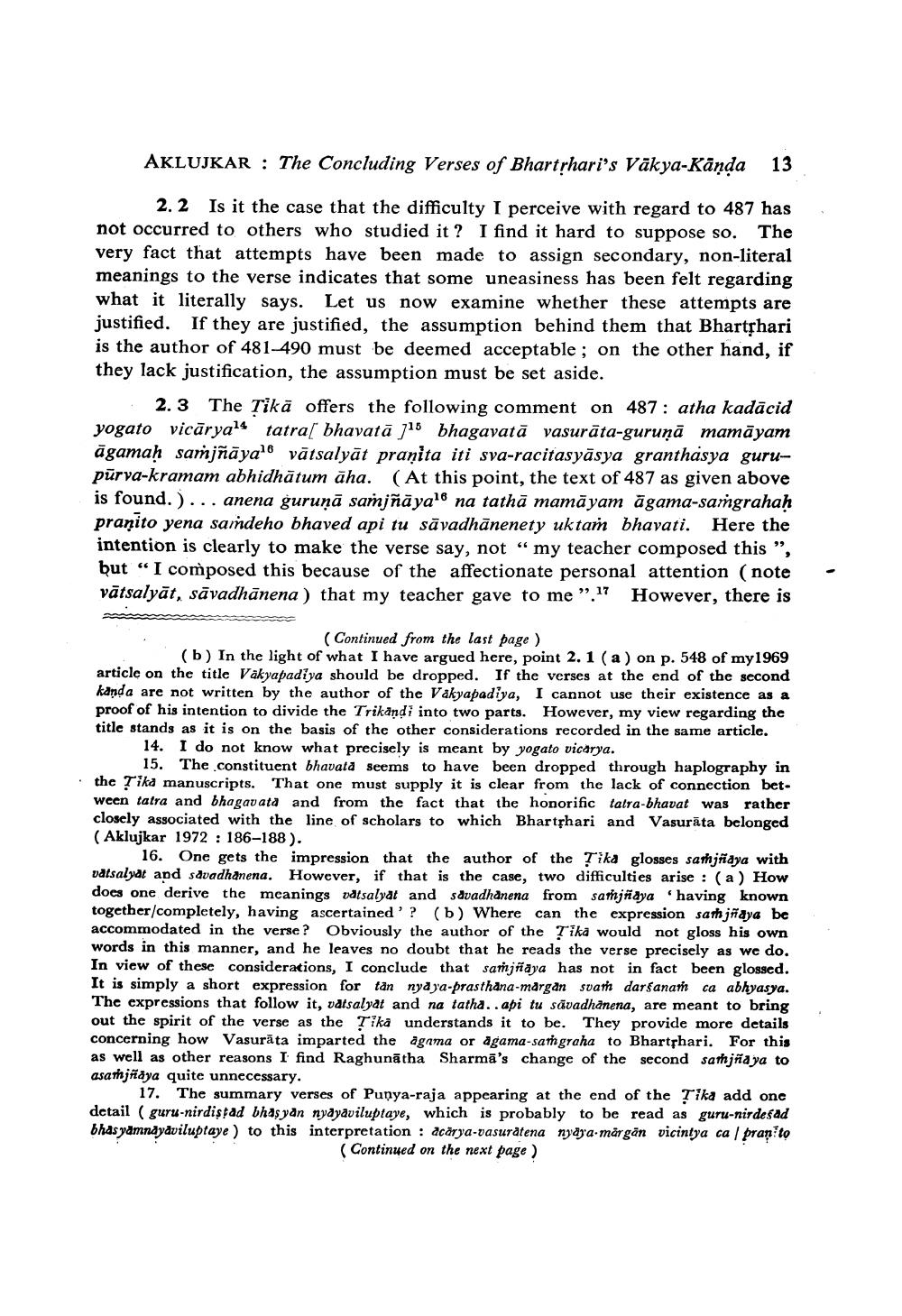Book Title: Concluding Verses Of Bhartrharis Vakya Kanda Author(s): Ashok Aklujkar Publisher: Ashok Aklujkar View full book textPage 5
________________ AKLUJKAR : The Concluding Verses of Bhartrhari's Vākya-Kāņda 13 2.2 Is it the case that the difficulty I perceive with regard to 487 has not occurred to others who studied it? I find it hard to suppose so. The very fact that attempts have been made to assign secondary, non-literal meanings to the verse indicates that some uneasiness has been felt regarding what it literally says. Let us now examine whether these attempts are justified. If they are justified, the assumption behind them that Bhartphari is the author of 481-490 must be deemed acceptable ; on the other hand, if they lack justification, the assumption must be set aside. 2.3 The Tikā offers the following comment on 487 : atha kadācid yogato vicāryal4 tatra[ bhavatā 715 bhagavatā vasurāta-guruņā mamāyam āgamaḥ samjñāya vātsalyāt pranita iti sva-racitasyāsya granthasya gurupūrva-kramam abhidhātum äha. (At this point, the text of 487 as given above is found.)... anena guruņā sarjñāyal na tathā mamāyam āgama-samgrahaḥ pranito yena samdeho bhaved api tu sāvadhānenety uktam bhavati. Here the intention is clearly to make the verse say, not “my teacher composed this ", but “I composed this because of the affectionate personal attention (note vātsalyāt, sāvadhānena) that my teacher gave to me".17 However, there is Continued from the last page) (b) In the light of what I have argued here, point 2.1 (a) on p. 548 of my 1969 article on the title Vakyapadiya should be dropped. If the verses at the end of the second kanda are not written by the author of the Vakyapadiya, I cannot use their existence as a proof of his intention to divide the Trikandi into two parts. However, my view regarding the title stands as it is on the basis of the other considerations recorded in the same article. 14. I do not know what precisely is meant by yogato vicarya. 15. The constituent bhavata seems to have been dropped through haplography in the Tika manuscripts. That one must supply it is clear from the lack of connection bet. ween tatra and bhagavata and from the fact that the honorific tatra-bhavat was rather closely associated with the line of scholars to which Bharthari and Vasurāta belonged (Aklujkar 1972 : 186-188). 16. One gets the impression that the author of the Tika glosses samhjaya with vatsalyat and sdvadhanena. However, if that is the case, two difficulties arise : (a) How does one derive the meanings vatsalyat and savadhanena from samjaya 'having known together/completely, having ascertained'? (b) Where can the expression sarhjaya be accommodated in the verse? Obviously the author of the Tika would not gloss his own words in this manner, and he leaves no doubt that he reads the verse precisely as we do. In view of these considerations, I conclude that samjïiaya has not in fact been glossed. It is simply a short expression for tàn nya ya-prasthana-margan suami darsanam ca abhyasya. The expressions that follow it, vatsalyat and na tatha.. api tu sävadhanena, are meant to bring out the spirit of the verse as the Tika understands it to be. They provide more details concerning how Vasurāta imparted the agama or agama-samgraha to Bhartphari. For this as well as other reasons I find Raghunātha Sharma's change of the second sathjia ya to asanjaya quite unnecessary. 17. The summary verses of Punya-raja appearing at the end of the Tika add one detail ( guru-nirdistad bhas yan nyayaviluptaye, which is probably to be read as guru-nirdesad bhas yamnayaviluptaye ) to this interpretation : acārya-vasuratena nyaya.märgān vicintya ca pran to (Continued on the next page)Page Navigation
1 ... 3 4 5 6 7 8 9 10 11 12 13 14 15 16 17 18
